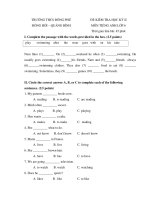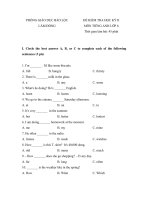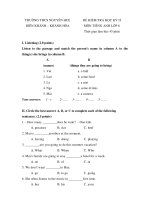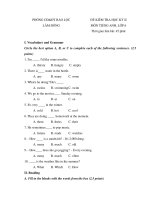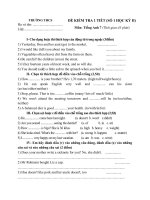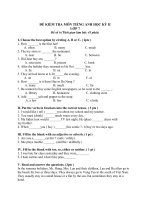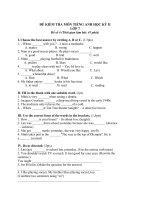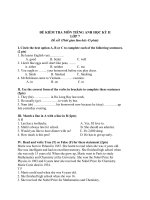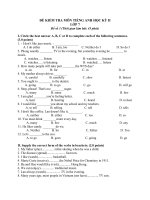De cuong thi trac nghiem hoc ki 2 mon Tieng Anh 9 phan Reading
Bạn đang xem bản rút gọn của tài liệu. Xem và tải ngay bản đầy đủ của tài liệu tại đây (126.2 KB, 16 trang )
<span class='text_page_counter'>(1)</span>UNIT 6 :. THE ENVIRONMENT. * Choose A, B, C or D to complete a complaint letter : (1,6ms) Dear sir / Madam, I am writing to you about the short stop of your trucks around my house on their way to the north. (1)________ the trucks of your company have a short break on the streets around my (2)________ , the drivers have left lots of garbage (3)________ the ground after their refreshment. When the trucks leave the place, the ground is covered with trash (4)________ a few minutes later there is smell and flies. I would suggest that your company should tell your drivers to clear up all the trash on the ground before leaving. I look forward to hearing from you and (5)________ good response from your company. Your faithfully, Pham Nguyen. 1. A. What B. Where C. When D. If (1) 2. A. village B. house C. town D. city (1) 3. A. at B. of C. in D. on (2) 4. A. if B. but C. because D. and (2) 5. A. see B. to see C. seeing D. to seeing. (3). ANSWER KEY- UNIT 6 : ( Mỗi câu đúng 0,2 điểm ) 1. C. 2. B. 3D. 4.D. 5. C.
<span class='text_page_counter'>(2)</span> UNIT 7 : SAVING ENERGY * Choose A, B, C or D to complete the passage SAVING ENERGY In Western countries, electricity, gas, and water are not luxuries (1)________ necessities. Companies now realize that consumers want (2)________that will not only work effectively, but also save money . For most North American households, lighting accounts for 10 percent to 15 percent of the electricity (3)________ . However, this amount can be reduced by replacing an ordinary 100-watt light bulb with an energy-saving bulb. These bulbs use a quarter of the (4)________of standard bulbs and last eight times (5)________ . Therefore consumers can save about US$7 to US$21 per bulbs… 1. A. if B. and C. or D. but (2) 2. A. presents B. things C. products D. machines (2) 3. A. bill B. menu C. payment D. book (1) 4. A. electricity B. electric C. electrnonics D. electrician (3) 5. A. long B. longer C. longest D. longer than (3) ANSWER KEY- UNIT 7 : ( Mỗi câu đúng 0,2 điểm ) 1.D. 2. C. 3. A. 4. A. 5. B. UNIT 8 : CELEBRATIONS.
<span class='text_page_counter'>(3)</span> * Choose A, B, C or D to complete the passage (1,6ms). TET Although there (1) ________ many celebrations throughout the yea, Tet or the (2)____ holiday is the most important celebration for (3) ________people. Tet is a festival which occurs in late January or early February. It is a time for families to clean and decorate their homes, and enjoy special food such as sticky rice cakes. Family members (4) ________ live apart try to be together at Tet. At Tet, spring fairs are organized and children are given lucky money wrapped in a red tiny envelope. Tet is also time for peace (5) ________ love. During Tet, children often behave well and friends, relatives and neighbors give each other best wishes for the new year.” 1. A. are (1) 2. A. Christmas Passover 3. A. English Malaysian 4. A. when (3) 5. A. and (2). B. is. C. was. D. were. B. Easter (1) B. Vietnamese (2) B. where. C. Lunar New Year. D.. C. American. D.. C. which. D. who. B. or. C. with. D. but. ANSWER KEY- UNIT 8 : ( Mỗi câu đúng 0,2 điểm ) 1. A 2. C 3. B 4. D 5. A -------------------------------------. UNIT 8 : CELEBRATIONS * Choose A, B, C or D to complete the passage (1,6ms) PARENT’S DAY In my opinion, it is important to have a day to celebrate for our parents. Children will have a special day to express their feelings, memories (1)________ love for their parents. We have (2)________ opportunity to enhance family traditions. Members of families can have a chance to get together, to know one another and to help one another. First Sunday of April is a day off, so everyone is free at work or study. And April is (3)________ late spring or early summer, so the weather is fine, and many activities can happen outdoor. Children should give their parents flowers, send them cards, or bring them a special cake and serve them the food (4)________they like best. I believe the idea will be supported and the day will (5)________ nationwide . Everybody loves and wants their parents to be happy. 1. A. or B. but.
<span class='text_page_counter'>(4)</span> C. with D. and. (2). A. a B. an C. the D. one. (2). A. on B. in C. at D. around. (2). A. what B. who C. whom D. that. (2). A. hold B. be celebrated C. be spent D. last. (3). 2.. 3.. 4.. 5.. ANSWER KEY- UNIT 8 : ( Mỗi câu đúng 0,2 điểm ) 1. D 2. B 3. B 4. D 5. B. I. Read text carefully, and then choose the correct answer. More than two hundred years ago, the term “environmental pollution” was quite strange to people, they lived healthily, drank pure water, and breathed fresh air. Nowadays, the situation is quite different. People all over the world are worried about things that are happening to the environment. Actually it is man that is destroying the surroundings with many kinds of wastes. Everybody knows that motorbikes and cars emit dangerous gases that cause poisonous air and cancer, but no one wants to travel on foot or by bicycle. Manufacturers know that wastes from factories make water and soil polluted, but they do not want to spend a lot of their money on treating the wastes safely. Scattering garbage is bad for our health, but no one wants to spend time burying it. Is it worth talking a lot about pollution?.
<span class='text_page_counter'>(5)</span> 1) More than two hundred years ago a. the environment was polluted as much as it is today b. people knew almost nothing about environmental pollution c. air was polluted badly d. people faced up to pollution Unit: 6 - Mức: 1 Key: b 2) Nowadays, many people are concerned about a. the poisonous air b. the polluted water c. the wastes from the factories . d. the environmental pollution. Unit: 6 - Mức: 2 Key: d 3) According to the passage, people know that motorbikes and cars emit dangerous gases a. so they do not travel by motorbikes and cars. b. so they prefer traveling by bicycles c. but they still prefer traveling by motorbikes and cars d. and they enjoy traveling on foot. Unit: 6 - Mức: 2 Key: c 4) Factory owners a. know nothing about pollution b. pollute water and soil c. spend a lot of money on treating wastes d. don’t treat industrial wastes safely Unit: 6 - Mức: 1 Key: d 5) Which of the followings is NOT true? a. In former days, people led a healthy life. b. People have no awareness of the danger of pollution c. Water is now heavily contaminated by industrial wastes. d. It’s harmful for our health if rubbish is spread over our areas. Unit: 6 - Mức: 3 Key: b. III. Read the text and do the tasks bellow Mr. Brown and some volunteer conservationists are on a very dirt beach now. Today they are ready to make the beach a clean and beautiful place again..
<span class='text_page_counter'>(6)</span> After listening to Mr. Brown’s instructions, they are divided into three groups. Group one needs to walk along the shore. Group two should check the sand, and Group 3 has to check among the rocks. Garbage must be put into plastic bags, and the bags will be collected by Mr. Jones. He will take the bags to the garbage dump. Each member is given a map to find the right place. They won’t eat the picnic lunch provided by Mrs. Smith until the whole area is clean. They are all eager to work hard so as to refresh this spoiled area. Answer the questions 1. Where are Mr. Brown and volunteer conservationists now? a) They are on the riverbanks b) They are on a very dirty beach now c) They are on the paddy field d) They are at the foot of a mountain and by a river. Unit: 6 - Mức: 1 Key: b 2. What do they do after listening to Mr. Brown’s instructions? a) They are all to clean the dirty beach b) They walk along the beach and collect the garbage c) They are divided into three groups, and do their work d) They go for a walk along the beach. Unit: 6 - Mức: 1 Key:c 3. What does Mr. Jones do? a) He collects the plastic bags to the garbage dump b) He prepares the lunch for everybody c) He checks the rock. d) He gives the map to everybody. Unit: 6 - Mức: 1 Key: a 4. Who provides a picnic lunch for everybody? a) Mr. Brown b) Mrs. Smith c) Mr. Jones d) The volunteer conservationists. Unit: 6 - Mức: 1 Key: b 5. What will they achieve if they work hard today? a) If they work hard they will refresh the spoiled beach b) If they work hard they will refresh the mountain c) If they work hard they will refresh the riverbanks d) If they work hard they will refresh the park Unit: 6. - Mức: 1. Key: a.
<span class='text_page_counter'>(7)</span> VI. Read the text and do the tasks that follow Almost all our energy comes from oil, coal, and natural gas. We call them fossil fuels. The earth’s fossil fuels are running out. What will happen when there is no coal, oil and gas on earth? Scientists are trying to find and use other alternative sources of energy. We can use energy from the sun, the wind, and the water. Solar energy is unlimited. The sun supplies all the energy used to grow plants, to evaporate water for rain, and to maintain the temperature of the planet. All are necessary for human life. If we are able to collect solar energy, we will be sure to have this abundant source of power. Another source of energy from nature is the wind which is clean and plentiful. Energy from the wind has been used for centuries to move ships, grind grain, pump water and do other forms of work. In recent time, wind has been used to generate electricity. Water can also provide power. For a long time, people have used water to power machines. Some early uses of water were to mill grain, saw wood and power machinery for the textile industry. Today water is mostly used to generate electricity. New words: Fossil fuels: nhiên liệu hoá thạch Abundant = rich: giàu có, nhiều To evaporate: bốc hơi nước To grind grain: xay lúa To saw wood: cưa cây, xẻ gổ Choose the best option to complete the sentences. 1. We are asking the question “What will happen when there is no oil, coal, and gas on earth?” because………………………………………………………………………… ……………. A. we are looking for other alternative sources of energy B. we are looking forward to seeing great changes. C. we are now depending so much on oil, coal and natural gas D. other sources of energy can come from the sun, the wind, and the water Unit: 7. - Mức: 2. Key: C. 2. Which pairs of words can be used alternatively? A. the sun / the wind B. energy / power.
<span class='text_page_counter'>(8)</span> C. rain / temperature D. plentiful / unlimited Unit: 7. - Mức: 2. Key: B. 3. Centuries ago, people used to………………………………………………... the. wind. power. A. maintain the earth’s temperature B. grow plants C. pump water D. generate electricity. Unit: 7. - Mức: 1. Key:C. 4. Up till now, water energy for………………………………………….. has. been. used. A. similar purposes B. moving ship C. the textile industry D. different purposes Unit: 7. - Mức: 1. Key: D. 5. The world “abundant” (in bold- type face) in the text probably means……………………. A. natural B. plentiful C. necessary D. unlimited Unit: 7. - Mức: 3. Key: B. IX. Read the following passage and answer the questions: (2pts) Electricity is the most common form of energy today. In the modern world, electricity is very available at the touch of a switch. Electricity has many uses. The most common use of electricity is to provide artificial lighting. In factories, electricity is used to light up the work place. It is also used to operate air-conditioners, computers and many other machines. Electricity is also used to power many appliances that we have in our homes such as television sets,.
<span class='text_page_counter'>(9)</span> computers, electric fans, irons and many others. The list is simply endless. Modern man will most probably be lost without electricity. 1. What is electricity used to do in factories? a) It is used to clean the work place. b) It is used to iron the clothes of the workers c) It is used to light up the work place. d) It is used to cook Unit: 7 - Mức: 1 Key: c 2. What are appliances? a) It is artificial lighting. b) It is furniture. c) It is machinery. d) They are television sets, electric fans, washing machines, and fridges. Unit: 7 - Mức: 2 Key: d 3. What should we do to save electricity at home? a) We should turn off the lights and other appliances before going out or after using them. b) We should turn off faucets after using c) We should turn on the lights before going out d) We should turn upon the lights before going out Unit: 7 - Mức: 3 Key: a. 4. What does the sentence “The list is simply endless” mean? a) Today we can’t use alternative sources of power except electricity. b) Electricity isn’t the most useful form of energy today c) There are fewer and fewer appliances in our homes. d) There are more and more appliances in our homes. Unit: 7 - Mức: 3 Key: d XI. Read the following passage and answer the questions Are you looking for a cheap, clean, effective source of power that doesn’t cause pollution or waste natural resources? Look no further than solar energy from our sun. At present, most of our electricity comes from the use of coal and gas, oil or nuclear power. This power could be provided by the sun. One percent of the solar energy that reaches the earth is enough to provide power for the total population. Many countries have already used solar energy. Solar panels are placed on the roofs of our house and the Sun’s energy is used to heat water. The energy can be stored for a number of days, so on cloudy days you can use solar energy, too. Sweden has an advanced solar energy program. There, all buildings will be heated by solar energy and cars will use solar energy instead of gas by the year 2015 1. Does solar energy cause pollution?.
<span class='text_page_counter'>(10)</span> a. Yes, it does. b. No, it doesn’t. c. No. Solar energy causes pollution d. Yes. Solar energy causes pollution Unit: 7 - Mức: 1 Key: b 2. How much solar energy is enough for the world’s population? a) Two percent of the solar energy. b) One- third of the solar energy. c) One– fifth of the solar energy. d) One percent of the solar energy. Unit: 7 - Mức: 1 Key: d 3. Where are solar panels installed? a) They are placed in the garden of the house. b) They are placed on the branches of the tall trees behind the house c) They are placed on the floor of the house d) They are placed on the roofs of the house Unit: 7 - Mức: 1 Key: d 4. How can we use solar energy on cloudy days? a) The energy can’t be stored for a number of days b) The energy can be stored for a number of days c) Solar energy can only use on the sunny days. d) The Sun’s energy is used to heat water. Unit: 7 - Mức: 2 Key: b. 5. When will cars use solar power instead of gas in Sweden ? a) by the year 2050 b) by the year 2055 c) by the year 2015 d) by the year 2035 Unit: 7 - Mức: 1 Key: c. READING UNIT EIGHT : CELEBRATIONS Choose the item among A, B, C or D that best answer the questions about the passage 1. A birthday is the day when a person was born. In many places, on a person’s birthday, he or she celebrates a party with friends and family. They eat cakes or other foods, and get gifts. In many English-speaking countries, people sing the song “Happy Birthday to You” to the person celebrating his birthday. There are similar songs in other languages..
<span class='text_page_counter'>(11)</span> A birthday cake is usually decorated and covered with candles. The number of candles is usually the same as the age of the birthday person. A birthday can give a person new responsibilities and rights. In the United States of America, a person can buy tobacco and pornography, vote, and become a legal adult at the age of 18. In Latin America, a quinceanera party marks a girl’s 15th birthday. 1. What does a person often do on his / her birthday? – Mức 2 A. makes a birthday cake B. has a birthday party C. wraps birthday gifts D. plays birthday games Key : B 2. Who is the song “Happy Birthday to You” sung to? - Mức 2 A. The person who celebrates his / her birthday. B. The person who attends the birthday party. C. The relatives of the birthday person. D. The guests come to the birthday party. Key : A 3. What is the birthday cake decorated with? - Mức 1 A. flowers. B. gifts. C. candles D. fruits Key : C 4. The number of candles is _________ the age of the birthday person. ? – Mức 1 A. the same as B. less than C. more than D. twice as much as Key : A 2. Tet is a national and family festival. It is an occasion for every Vietnamese to have a good time thinking about the last year and the next year. At Tet, spring fairs are organized, streets, and public buildings are brightly decorated and almost all shops are crowded with people shopping for Tet. At home, everything is tidied, special food is cooked, offerings of foods, fresh water, flowers and betel are made on the family altar with burning joss-sticks scenting the air. First-footing is made when the first visitor comes and children are given lucky money wrapped in a red tiny envelope. Tet is also time for peace and love. During Tet, children often behave well and friends, relatives and neighbors give each other best wishes for the New Year. 1. What do people do to prepare for Tet? – Mức 2.
<span class='text_page_counter'>(12)</span> A. People often tidy and paint their house, go shopping for Tet and cook special food. B. People often tidy, build and decorate their house, go to the market for Tet and cook special food. C. People often tidy, paint, build and decorate their house, go shopping for Tet and cook special food D. People often tidy and decorate their house, go shopping for Tet and cook special food. Key : D 2. What is first-footing? – Mức 3 A. First-footing is a Vietnamese tradition made when the first visitor comes to give best wishes on the first day of the New Year. B. First-footing is a Vietnamese custom made when the first visitor comes to give best wishes on the first day of the New Year. C. First-footing is a Vietnamese holiday made when the first visitor comes to give best wishes on the first day of the New Year. D. First-footing is a Vietnamese custom made when the many visitors come to give best wishes on the first day of the New Year. Key : B 3. What do children often receive at Tet? – Mức 2 A. Children often receive peace and love from their parents. B. Children often receive special food in their family C. Children often receive a lot of money wrapped in a red tiny envelope. D. Children often receive lucky money wrapped in a red tiny envelope. Key : D 4. What do people do during Tet? – Mức 3 A. During Tet, people often behave well and friends, relatives and neighbors give each other best wishes for the New Year. B. During Tet, people often behave well with children and friends, relatives and neighbors give each other best wishes for the New Year. C. During Tet, children often behave well and best wishes for the New Year are given each other by friends, relatives and neighbors. D. During Tet, children don’t often behave well and friends, relatives and neighbors give each other best wishes for the New Year. Key : C 3. Christmas is the biggest festival of the year in most western countries. Celebrations start properly on December 24, Christmas Eve, although there have been several weeks of preparations beforehand. The Christmas tree and all the presents, food, drinks and decorations have been bought. Christmas cards have already been sent to friends and relatives. About a week before Christmas people.
<span class='text_page_counter'>(13)</span> usually put up their decorations and decorate the Christmas tree with electronic lights, various colored decorations and an angel on the top. Family presents are usually put under the Christmas tree. Christmas Day, December 25, is the biggest day of the holiday. On the Christmas morning (often very early), children open the presents that are in their socks. Many families go to church. The traditional Christmas dinner consists of roast turkey with potatoes and various other vegetables. Before the dinner, people usually pull crackers – small rolls of paper that have gifts, jokes, and party hats inside. 1. When is the Christmas tree usually decorated? – Mức 1 A. Several weeks before Christmas B. About a week before Christmas C. On December 24 D. On December 25 Key : B 2. What is on the top of the Christmas tree? – Mức 1 A. a light B. an angel C. a present D. a colored decoration Key : B 3. When are the presents opened? – Mức 2 A. On the Christmas morning B. On the Christmas afternoon C. On Christmas Eve D. On December 24 Key : A 4. Which of the following is the traditional Christmas dinner? – Mức 2 A. Roast turkey with potatoes and bread. B. Roast beef with potatoes and various other vegetables. C. Roast turkey with tomatoes and various other vegetables. D. Roast turkey with potatoes and various other vegetables. Key : D 5. Which of the following is NOT mentioned in the passage? – Mức 3 A. Christmas Eve is the time all Christians gathering together. B. Christmas is the biggest festival of the most Western countries C. Christmas Day is the biggest day of the holiday. D. Christmas crackers are small rolls of paper that have gifts, jokes and party hats inside. Key : A 4. In the United States, people celebrate Mother’s Day and Father’s Day. Mother’s Day is celebrated on the second Sunday in May. On this occasion,.
<span class='text_page_counter'>(14)</span> mother usually receives greeting cards and gifts from her husband and children. The best gift of all for an American Mom is a day of leisure. The majority of American mothers have outside jobs as well as housework, so their working days are often very hard. The working mother enjoys the traditional Mother’s Day custom of breakfast cooked by her family and served to her on a tray in bed. Later on that day, it’s also traditional for the extended family group to get together for dinner, either in a restaurant or in one of their homes. Flower is an important part of Mother’s Day. Mothers are often given a plant for the occasion, particularly if they are elderly. Father’s Day is celebrated throughout the United States and Canada on the third Sunday in June. The holiday customs are similar to Mother’s Day. Dad also receives greeting cards and gifts from his family and enjoys a day of leisure. 1. When do American people celebrate Mother’s Day and Father’s Day? – Mức 1 A. On the second Sunday in June and Father’s Day on the third Sunday in May B. On the second Sunday in May and Father’s Day on the third Sunday in June C. On the third Sunday in May and Father’s Day on the second Sunday in June D. On the third Sunday in June and Father’s Day on the second Sunday in May Key : B 2. What kinds of gifts do mothers often get from her family members? – Mức 2 A. Greeting cards and gifts from her family members. B. Greeting cards and a day of leisure from her family members. C. Greeting cards, gifts and a day of leisure from her family members. D. Greeting wishes, greeting cards, gifts and a day of leisure from her family members. Key : C 3. Where do the family members have their dinner party on this occasion? – Mức 2 A. In a restaurant or in the park. B. In a restaurant and in one of their homes. C. In a restaurant only D. In a restaurant or in one of their homes. Key : D 4. In Vietnam, when are Mother’s Day and Father’s Day celebrated? – Mức 3 A. Mother’s Day and Father’s Day are celebrated on March 8 every year B. Mother’s Day is celebrated on March 8 and father’s Day is on another day.
<span class='text_page_counter'>(15)</span> C. In Vietnam, they often celebrate Mother’s Day and Father’s Day on New Year’s Day D. The author hasn’t mentioned Mother’s Day and Father’s Day in Vietnam yet Key : D UNIT NINE : NATURAL DISASTERS Choose the item among A, B, C or D that best answer the questions about the passage. 1. The large movement of earth under the water causes a very large and powerful tsunami. The tsunami was called the Asian Tsunami in most of the world. It was called the Boxing Day Tsunami in England, Australia, South Africa and Canada because it happened on the holiday they call Boxing Day. The tsunami caused a lot of damage to countries such as Philippines, Thailand, Indonesia and Sri Lanka. Waves as high as 30m killed many people and damaged or destroyed a lot of buildings and other properties. Over 225,000 people died or were not found after the Tsunami. The wave traveled as far away as South Africa (8000km) where as many as 8 people died because of high water caused by the wave. Because of how much damage was caused and the number of people the earthquake affected, over $ 7 billion was donated to help the survivors and rebuild the areas damaged. 1. Why was the tsunami called the Boxing Day Tsunami in England? – Mức 2 A. Because it happened when people were boxing. B. Because it happened when people were collecting boxes. C. Because it happened on Boxing Day. D. Because it destroyed a lot of boxes. Key : C 2. How high were the waves? – Mức 1 A. Thirteen meters B. Eighteen meters C. Thirty meters D. Two hundred and twenty-five meters Key : C 3. What were some people in South Africa killed by? – Mức 1 A. Earthquake B. High water C. High wind D. Property Key : B 4. What does the word ‘survivors’ in line 11 mean? – Mức 2 A. houses that aren’t destroyed B. offices that are being built..
<span class='text_page_counter'>(16)</span> C. people that are dead D. people that are left alive Key : D 5. Which of the following is NOT true? – Mức 3 A. Only in Asia the tsunami was called Asian Tsunami. B. The tsunami caused a lot of damage to Indonesia. C. Many people died because of the high waves D. A lot of money was raised to help people. Key : A.
<span class='text_page_counter'>(17)</span>

